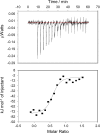Outer domain of HIV-1 gp120: antigenic optimization, structural malleability, and crystal structure with antibody VRC-PG04
- PMID: 23236069
- PMCID: PMC3571475
- DOI: 10.1128/JVI.02717-12
Outer domain of HIV-1 gp120: antigenic optimization, structural malleability, and crystal structure with antibody VRC-PG04
Abstract
The outer domain of the HIV-1 gp120 envelope glycoprotein contains the epitope for broadly neutralizing antibodies directed to the CD4-binding site, many of which are able to neutralize over 90% of circulating HIV-1 isolates. While the outer domain is conformationally more stable than other portions of the HIV-1 envelope, efforts to express the outer domain as an immunogen for eliciting broadly neutralizing antibodies have not been successful, potentially because natural outer domain variants do not bind strongly to antibodies such as VRC01. In this study, we optimized the antigenic properties of the HIV-1 Env outer domain to generate OD4.2.2, from the KER2018 strain of clade A HIV-1, enabling it to bind antibodies such as VRC01 with nanomolar affinity. The crystal structure of OD4.2.2 in complex with VRC-PG04 was solved at 3.0-Å resolution and compared to known crystal structures including (i) the structure of core gp120 bound by VRC-PG04 and (ii) a circularly permutated version of the outer domain in complex with antibody PGT128. Much of the VRC-PG04 epitope was preserved in the OD4.2.2 structure, though with altered N and C termini conformations. Overall, roughly one-third of the outer domain structure appeared to be fixed in conformation, independent of alterations in termini, clade, or ligand, while other portions of the outer domain displayed substantial structural malleability. The crystal structure of OD4.2.2 with VRC-PG04 provides atomic-level details for an HIV-1 domain recognized by broadly neutralizing antibodies and insights relevant to the rational design of an immunogen that could elicit such antibodies by vaccination.
Figures


 ) below the OD4.2.2 sequence.
) below the OD4.2.2 sequence.







References
-
- Korber B, Gaschen B, Yusim K, Thakallapally R, Kesmir C, Detours V. 2001. Evolutionary and immunological implications of contemporary HIV-1 variation. Br. Med. Bull. 58:19–42 - PubMed
-
- Kwong PD, Doyle ML, Casper DJ, Cicala C, Leavitt SA, Majeed S, Steenbeke TD, Venturi M, Chaiken I, Fung M, Katinger H, Parren PW, Robinson J, Van Ryk D, Wang L, Burton DR, Freire E, Wyatt R, Sodroski J, Hendrickson WA, Arthos J. 2002. HIV-1 evades antibody-mediated neutralization through conformational masking of receptor-binding sites. Nature 420:678–682 - PubMed
-
- Wei X, Decker JM, Wang S, Hui H, Kappes JC, Wu X, Salazar-Gonzalez JF, Salazar MG, Kilby JM, Saag MS, Komarova NL, Nowak MA, Hahn BH, Kwong PD, Shaw GM. 2003. Antibody neutralization and escape by HIV-1. Nature 422:307–312 - PubMed
-
- Wu X, Zhou T, Zhu J, Zhang B, Georgiev I, Wang C, Chen X, Longo NS, Louder M, McKee K, O'Dell S, Perfetto S, Schmidt SD, Shi W, Wu L, Yang Y, Yang ZY, Yang Z, Zhang Z, Bonsignori M, Crump JA, Kapiga SH, Sam NE, Haynes BF, Simek M, Burton DR, Koff WC, Doria-Rose NA, Connors M, Mullikin JC, Nabel GJ, Roederer M, Shapiro L, Kwong PD, Mascola JR. 2011. Focused evolution of HIV-1 neutralizing antibodies revealed by structures and deep sequencing. Science 333:1593–1602 - PMC - PubMed
Publication types
MeSH terms
Substances
Associated data
- Actions
- Actions
Grants and funding
LinkOut - more resources
Full Text Sources
Other Literature Sources
Research Materials

